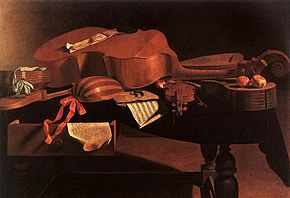
Back Barokmusiek Afrikaans Barockmusik ALS موسيقى باروكية Arabic مزيكا باروكيه ARZ Música barroca AST Barokko (musiqi) Azerbaijani Barokna muzika BS Música barroca Catalan مۆسیقای بۆرۆک CKB Barokní hudba Czech

| Major eras of Western classical music | ||||||||||||
|---|---|---|---|---|---|---|---|---|---|---|---|---|
| Early music | ||||||||||||
|
||||||||||||
| Common practice period | ||||||||||||
|
||||||||||||
| New music | ||||||||||||
|
||||||||||||
Baroque music (UK: /bəˈrɒk/ or US: /bəˈroʊk/) refers to the period or dominant style of Western classical music composed from about 1600 to 1750.[1] The Baroque style followed the Renaissance period, and was followed in turn by the Classical period after a short transition (the galant style). The Baroque period is divided into three major phases: early, middle, and late. Overlapping in time, they are conventionally dated from 1580 to 1650, from 1630 to 1700, and from 1680 to 1750. Baroque music forms a major portion of the "classical music" canon, and is widely studied, performed, and listened to. The term "baroque" comes from the Portuguese word barroco, meaning "misshapen pearl".[2] The works of Antonio Vivaldi, George Frideric Handel and Johann Sebastian Bach are considered the pinnacle of the Baroque period. Other key composers of the Baroque era include Claudio Monteverdi, Domenico Scarlatti, Alessandro Scarlatti, Alessandro Stradella, Tomaso Albinoni, Johann Pachelbel, Henry Purcell, Georg Philipp Telemann, Jean-Baptiste Lully, Jean-Philippe Rameau, Marc-Antoine Charpentier, Arcangelo Corelli, François Couperin, Johann Hermann Schein, Heinrich Schütz, Samuel Scheidt, Dieterich Buxtehude, Gaspar Sanz, José de Nebra, Antonio Soler, Carlos Seixas, Adam Jarzębski and others, with Giovanni Battista Pergolesi being the most prominent Baroque composer of sacred music.
The Baroque saw the formalization of common-practice tonality, an approach to writing music in which a song or piece is written in a particular key; this type of harmony has continued to be used extensively in Western classical and popular music. During the Baroque era, professional musicians were expected to be accomplished improvisers of both solo melodic lines and accompaniment parts. Baroque concerts were typically accompanied by a basso continuo group (comprising chord-playing instrumentalists such as harpsichordists and lute players improvising chords from a figured bass part) while a group of bass instruments—viol, cello, double bass—played the bassline. A characteristic Baroque form was the dance suite. While the pieces in a dance suite were inspired by actual dance music, dance suites were designed purely for listening, not for accompanying dancers.
During the period composers experimented with finding a fuller sound for each instrumental part (thus creating the orchestra),[2] made changes in musical notation (the development of figured bass as a quick way to notate the chord progression of a song or piece), and developed new instrumental playing techniques. Baroque music expanded the size, range, and complexity of instrumental performance, and also established the mixed vocal/instrumental forms of opera, cantata and oratorio and the instrumental forms of the solo concerto and sonata as musical genres. Dense, complex polyphonic music, in which multiple independent melody lines were performed simultaneously (a popular example of this is the fugue), was an important part of many Baroque choral and instrumental works. Overall, Baroque music was a tool for expression and communication.[1]
- ^ a b Palisca 2001.
- ^ a b Mackay & Romanec 2007.